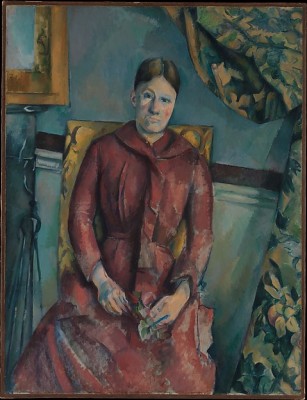
Paul Cézanne, “Madame Cézanne in a Red Dress,” oil on canvas, 1888-90 (The Mr. and Mrs. Henry Ittleson Jr. Purchase Fund, 1962)
Metropolitan Museum of Art, Galleries 955 & 961–962
1000 Fifth Ave. at 82nd St.
Daily through March 15, recommended admission $12-$25
212-535-7710
www.metmuseum.org
Not much is known about the relationship between French artist Paul Cézanne and his wife, former artist’s model Marie-Hortense Fiquet, other than that they met in 1869, had a son in 1872, were married in 1886, and, when Paul died in 1906, had long lived apart, and he left her nothing in his will. However, he did leave behind twenty-nine known portraits of her, twenty-five of which are on display at the Met in the intriguing exhibition “Madame Cézanne,” continuing through March 15. The show features paintings, drawings, and watercolors, ranging from a page of 1871-74 graphite studies to the ca. 1895-1900 oil sketch “Portrait of a Woman (Madame Cézanne).” The centerpiece of the exhibit is the quartet of portraits of Madame Cézanne in a red dress, each one very different, highlighted by the 1888-90 canvas with the most detailed surroundings. The four paintings have not been seen together for many years, and the group, now side by side, is both breathtaking and provoking in the insights it offers and questions it generates about Cezanne’s choices on the canvas. The paintings do not add insight into the couple’s love, or lack thereof, for each other, however, as Cézanne nearly always depicts his wife as dour and matronly, rarely smiling. In the unfinished 1891 oil painting “Madame Cézanne” in the Conservatory,” Hortense Fiquet sits on a chair, her hands on her lap, tree branches and fruit in the background; she gazes directly at the viewer, her eyes open, her mouth closed, appearing neither sad nor happy, just resigned to her fate. “If these quietly powerful paintings of Hortense Fiquet came to be acknowledged as a testing ground for Cézanne’s innovation and experimentation with paint on canvas, their subject and her vital partnership as model, mistress, wife, and mother have been willfully overlooked,” curator Dita Amory writes in the preface to the exhibition catalog. “Their story is a deeply compelling one, perhaps even more so for the very absence of its particulars.” What isn’t absent in this show are some very beautiful works, which add yet more mystery to this curious artistic relationship. (As a bonus, the Met is showing “Paul Cézanne: Drawings and Watercolors” in Gallery 960 in the Robert Lehman Wing, also through March 15.)